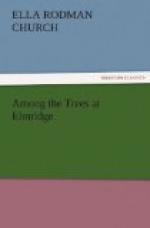“I should think it ought to belong to the pea family,” said Malcolm, “if the flowers are shaped like pea-blossoms.”
“So it does,” replied Miss Harson—“or, rather, to the bean family, of which the pea is a member, on account of its blossoms; but the acacia, like many others, is a brother, or sister, on account of its leaves as well as its blossoms. The peculiar distinction of this family is that its flowers are butterfly-shaped or its fruit in pods, and it often possesses both these characters. By one or the other all the plants of the family are known, and the butterfly-shaped flowers are of a character not to be mistaken, as they are found in no other family. It includes herbs, shrubs and trees—an immense and perfectly natural family, distributed throughout almost every part of the globe. There are at present in all not less than thirty-seven hundred species. So you see that the locust tree is certainly rich in relations.”
The children thought that it must have some family claim on almost every plant in the world.
[Illustration: CAROB TREE AND FRUIT.]
“Do you remember that in the story of the Prodigal Son, told by our Lord, it is said that the bad son became so poor that he wanted to eat the ‘husks’ that the swine ate? Those ‘husks’ were the fruit of a Syrian member of this family. The tree is the carob tree, of which you have here a picture—a fine large tree bearing a sweet pod containing the seeds. I have seen these pods for sale in this country, and foolishly called St. John’s bread, as if the ‘locusts’ eaten by John the Baptist were pods of a locust tree, and not insect locusts.”
“Yes,” said Malcolm, “I have tasted those pods, and they are real sweet; but I wouldn’t care to make a breakfast from them.”
“I like calling the flowers ‘butterfly-shaped,’” said Clara, “because that is just what the pea and bean-blossoms look like; though Kitty calls ’em ‘little ladies in hoods.’ Isn’t that funny, Miss Harson?”
“It is very quaint, I think, but I do not dislike it: it is like seeing faces in pansies; and some people are full of these odd imaginations. There is a kind of locust, called the clammy-barked, found in the Southern parts of the United States, which is a smaller tree than the common locust and has large pale-pink flowers, while the rose acacia is a very beautiful flowering shrub. The sweet, or honey, locust is another variety, which is also called the three-thorned acacia, because the thorns consist of one long spine with two shorter ones projecting out of it, like little branches, near its base. This is said to display much of the elegance of the tropical acacia in the minute division and symmetry of its compound leaves. These are of a light and brilliant green and lie flat upon the branches, giving them a fan-like appearance such as we observe in the hemlock.”
“But why is it called honey-locust?” asked Malcolm. “Do the bees make honey in the trunk?”




